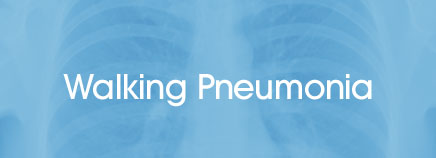
During the school year, it can seem like kids pick up one bug after another. One week it’s a runny nose, the next a sore throat, or both. Most of the time, these bugs only last for about a week. But those that linger on for longer can sometimes turn into walking pneumonia.
Walking pneumonia, or atypical pneumonia, is a less serious form of the lung infection pneumonia. It’s caused by Mycoplasma bacteria, which causes cold-like symptoms in addition to a low-grade fever and a hacking cough.
Most kids with this form of pneumonia will not feel sick enough to stay at home — hence, the name “walking” pneumonia — and usually will feel well enough to go to school. But even a child who feels fine needs to stay at home for a few days until antibiotic treatment kicks in and symptoms improve.
Signs and Symptoms
Colds that last longer than 7 to 10 days or respiratory illnesses like respiratory syncytial virus (RSV) can develop into walking pneumonia. Symptoms can come on suddenly or take longer to appear. Those that have a slow onset tend to be more severe.
Here’s what to look for:
- low-grade fever of 101°F (38.5°C) or below
- headache, chills, sore throat, and other cold or flu-like symptoms
- rapid breathing or breathing with grunting or wheezing sounds
- labored breathing that makes the rib muscles retract (when muscles under the ribcage or between ribs draw inward with each breath)
- hacking cough
- chest pain or stomach pain
- malaise (feeling of discomfort)
- vomiting
- loss of appetite (in older kids) or poor feeding (in infants)
Symptoms usually depend on where in the body the infection is concentrated. A child whose infection is in the top or middle part of the lungs will probably have labored breathing. Another whose infection is concentrated in the lower part of the lungs (near the abdomen) may not have breathing problems at all, but may have an upset stomach, nausea, or vomiting.
Diagnosis
Walking pneumonia is usually diagnosed through a physical examination. The doctor will monitor your child’s breathing and listen for a hallmark crackling sound that often indicates walking pneumonia.
If pneumonia is suspected, a chest X-ray or bacterial culture of mucus from the throat or nose might be done to confirm the diagnosis.
Treatment
Antibiotics are an effective treatment for walking pneumonia. A 7- to 10-day course of oral antibiotics is usually recommended. If your doctor prescribes antibiotics, make sure your child takes them on schedule for as long as directed to recover more quickly.
Once on antibiotics, your child has a minimal risk of passing the illness on to other family members, but encourage everyone in your household to wash their hands frequently and correctly (for at least 20 seconds, rubbing hands together with soap and warm water).
Don’t let your child share drinking glasses, eating utensils, towels, or toothbrushes, and remind everyone to wash their hands after touching any used tissues. Also make sure that your kids are up to date on their immunizations to help protect them from other infections.
Home Health
While recovering from walking pneumonia, your child should drink fluids throughout the day to flush the system and rid the body of toxins (especially if he or she has a fever). Ask the doctor before you use a medicine to treat a cough because cough suppressants stop the lungs from clearing mucus, which may not always be helpful for lung infections like walking pneumonia.
If your child has chest pain, try placing a heating pad or warm compress on the chest area. Take your child’s temperature at least once each morning and each evening, and call the doctor if it goes above 102°F (38.9°C) in an older infant or child, or above 100.4°F (38°C) in an infant under 6 months of age.
With treatment, most types of bacterial pneumonia go away within 1 to 2 weeks. However, walking pneumonia can take up to 4 to 6 weeks to resolve completely.

